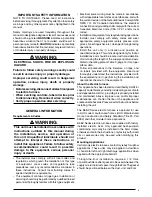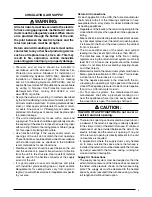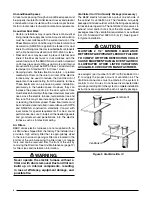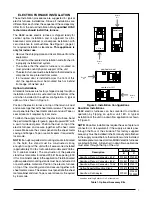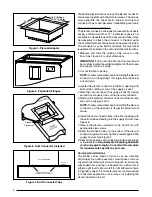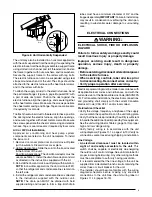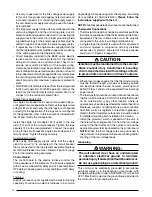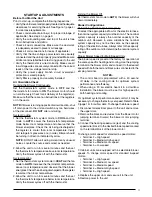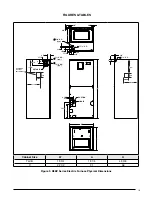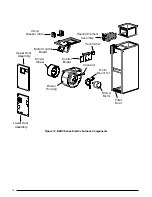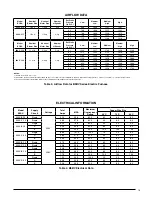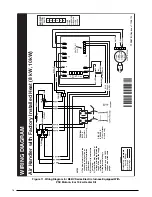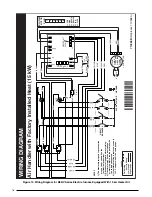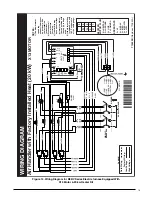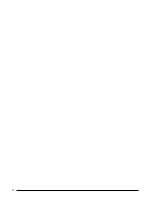
9
Figure 8. Unit horizontally Suspended
Threaded
Rod
Lag
Bolt
Nuts (x2)
Washer
and
Lockwasher
Nuts (x2)
ELECTRICAL CONNECTIONS
WARNING:
ELECTRICAL ShOCK, FIRE OR EXPLOSION
hAZARD
Failure to follow safety warnings exactly could
result in serious injury or property damage.
Improper servicing could result in dangerous
operation, serious injury, death or property
damage.
• Before servicing, disconnect all electrical power
to the electric furnace.
• When servicing controls, label all wires prior
to disconnecting. Reconnect wires correctly
.
• Verify proper operation after servicing.
Electrical power wiring must be made in accordance with
all applicable local codes and ordinances, and with the
current revision of the National Electric Code (ANSI/NFPA
70). For Canadian installations, the electrical connections
and grounding shall comply with the current Canadian
Electrical Code (CSA C22.1 and/or local codes).
Pre-Electrical Checklist
√
Verify the voltage, frequency, and phase of the supply
source match the specifications on the unit rating plate.
√
Verify that the service provided by the utility is sufficient
to handle the additional load imposed by this equipment.
See the unit wiring label or Table 4 (page 15) for proper
high and low voltage wiring.
√
Verify factory wiring is in accordance with the unit
wiring diagrams (Figures 11-14, pages 16-19). Verify no
connections came loose during shipping or installation.
Line Voltage
•
An electrical disconnect must be located within
sight of and readily accessible to the unit
. This
switch shall be capable of electrically de-energizing
the outdoor unit control voltage. See unit data label for
proper incoming field wiring. Any other wiring methods
must be acceptable to authority having jurisdiction.
• It is recommended that the line voltage to the unit be
supplied from a dedicated branch circuit containing the
correct fuse or circuit breaker for the unit.
• The installer should become familiar with the wiring
diagram/schematic before making any electrical
connections to the unit. See the unit wiring label or
Figures 11-14 (pages 16-19).
The unit may also be installed in a horizontal application
with the unit suspended from the ceiling. If suspending the
electric furnace from the ceiling, assemble a support frame
using slotted iron channel and full threaded rod. Fasten
the frame together with nuts, washers, and lockwashers.
Secure the support frame to the rafters with lag bolts.
The electric furnace can also be suspended using steel
straps around each end of the unit. The straps should be
attached to the electric furnace with sheet metal screws
and to the rafters with bolts.
To attach the supply air duct to the electric furnace, bend
the perforated flanges (Figure 5, page 8) upward 90° with
a pair of wide duct pliers. Position the duct against the
electric furnace, align the openings, and secure together
with sheet metal screws. Make sure the screws penetrate
the sheet metal casing and flange. Tape or seal all seams
if required by local code.
To attach the return air duct to the electric furnace, position
the duct against the electric furnace, align the openings,
and secure together with sheet metal screws. Make sure
the screws penetrate the sheet metal casing and electric
furnace. Tape or seal all seams if required by local code.
A/C or h/P Coil Installation
Approved air conditioning and heat pump system
components are listed on the unit nameplate. To install
the indoor coil:
1. Remove door cover plate, door and coil close-off plate
(with insulation). Discard door cover plate.
2. Upflow Applications: Slide the coil into the track located
in the bottom of the unit.
Downflow Applications: The downflow adaptor must be
used (see Table 1). Install the downflow adaptor and coil
as directed in the instructions supplied with the kit.
3. Reinstall the door and coil close-off plate (with insulation).
NOTE:
In downflow applications the door is rotated 180°
so that the refrigerant and condensate lines remain on
the left side.
4. Install the refrigerant and condensate lines as directed
in the instructions supplied with the outdoor unit.
NOTE:
The drain pan MUST be drained with field
supplied tubing and looped to form a trap. Both drain
tubes must have a minimum diameter of 3/4” and be
trapped separately.
IMPORTANT:
Failure to install a trap
may result in condensation overflowing the drain pan,
resulting in substantial water damage to surrounding
area.



